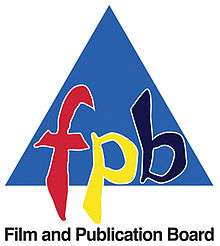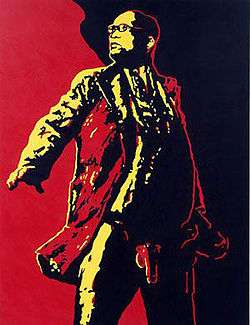Film and Publication Board
 FPB logo | |
| Formation | 1996 |
|---|---|
| Type | Film ratings, censorship, online regulation |
| Headquarters |
Centurion, Gauteng South Africa |
| Thoko Mpumlwana | |
| Website |
www |
The Film and Publication Board, often shortened to FPB is a content-classification and censorship authority in South Africa, operating under the Minister of Communications (South Africa).
The FPB was established and created under the Films and Publications Act, 1996, ostensibly to tackle issues of child pornography and child abuse, as well as to provide ratings to publicly consumed media such as movies, music and television programs. Under these directives, its mandate can be considered one of state censorship.
The FPB came under intense criticism of its handling of the The Spear debacle, in which it issued a painting in gallery that depicted President Jacob Zuma with his genitals exposed, with an "16N" rating. This was widely considered to be a move that was beyond its statutory remit. On appeal, the FPB revoked the rating.
Overview
History
The Film and Publication Board was established directly under the directive set out in the Films and Publications Act of 1996, shortly after South Africa achieved independence from apartheid rule. The Board's function would be to receive complaints - or applications to evaluate - a film or publication, to classify it according to its suitability for different audiences. These publications could include movies, television programs, computer games, and music.
The classification of a film or publication would trigger various prohibitions on possessing, exhibiting, distributing or advertising the film or publication. Different ratings were devised, the most serious of which was "X18", which prohibited anyone without a specific license from distributing the content, which had to be conducted within "adult premises".
Certain key exemptions from prohibitions were made to the scientific community (in regard to bona fide scientific, documentary, dramatic, artistic, literary or religious films and publications), and the media (in that those holding a broadcasting license were exempt form the duty to apply for classification).
An appeals process was also defined under the Act, allowing rulings made by the FPB to be contested and challenged.
Ratings
The FPB has the following ratings guideline:
| Rating | Description |
|---|---|
| A | All Ages |
| PG | All Ages allowed, but some parental guidance is recommended for younger or sensitive viewers. |
| 7-9 PG | Material may not be suitable for children under 7, but a caregiver or parent may decide if children between 7 and 9 years old may access the material. |
| 10-12 PG | Material may not be suitable for children under 10, but a caregiver or parent may decide if children between 10 and 12 years old may access the material. |
| 16 | Not suitable for persons under the age of 16 |
| 18 | Not suitable for persons under the age of 18 |
| X18 | Adults only. Only licensed, adults-only designated businesses may distribute this content, and never to minors. X18 content may not be broadcast on public media such as television or radio. |
| XX | Banned. Cannot be legally sold, rented or exhibited anywhere in South Africa. The FPB has the authority to classify any content as XX if it contains bestiality, necrophilia, extreme violence and/or cruelty, extreme sexual violence or the glorification of crime or child pornography. |
Additionally, the FPB provides the following content classifications:
| Rating | Description |
|---|---|
| S | Sex |
| N | Nudity |
| L | Language |
| H | Horror |
| V | Violence |
| P | Prejudice |
| SV | Sexual Violence |
| D | Substance Abuse |
Criticism
The Spear

In 2012, the Goodman Gallery in Cape Town, showcased a painting by artist Brett Murray. It depicted President Jacob Zuma in a pose reminiscent of Lenin, but with fully exposed genitalia. The painting drew swift condemnation from the ANC ruling party, who condemned the artist, the artwork, and all media outlets who had published images of the painting.[1][2]
Shortly after, the Film and Publication board sent five assessors to provide a rating for the artwork[3] - a move that was harshly criticised for being well outside its mandate, and beyond the remit of the purpose of the FPB. Despite this, the FPB issued an "16N" rating, which meant that the Gallery could no longer publicly show the painting if there were children in the building.
During the classification proceedings, there were allegations that the FPB was acting outside its statutory remit, and that specific members had made statements or asked questions implying that it was entitled to censor political opinions and restrict freedom of the press.[4]
This decision was later appealed following a public backlash, and amidst accusations of state-led censorship. Upon appeal in October 2012, the FPB set aside its original rating, thereby effectively de-classifying the painting. This had taken place after the painting was famously defaced and sold, which rendered the ruling moot on practical terms.[5][6][7]
Draft Online Regulation Policy
In March 2015, the FPB gazetted a notice inviting public comment a Draft Online Regulation policy, that sought sweeping new powers to effectively police and regulate all aspects of content on the internet.[8] In this draft policy, the FPB seeks to classify all manner of content, including, for instance, user-submitted videos to sites such as YouTube, which would require all such content to first be classified by the FPB at a charge, and labelled as FPB-approved before it would be allowed to be legally published online.
Specifically, the following sections from the draft detail the broadness of the powers FPB seek:
- 5.1.1 Any person who intends to distribute any film, game, or certain publication in the Republic of South Africa shall first comply with section 18(1) of the Act by applying, in the prescribed manner, for registration as film or game and publications distributor.
- 5.1.2 In the event that such film, game or publication is in a digital form or format intended for distribution online using the internet or other mobile platforms, the distributor may bring an application to the Board for the conclusion of an online distribution agreement, in terms of which the distributor, upon payment of the fee prescribed from time to time by the Minister of DOC as the Executive Authority, may classify its online content on behalf of the Board, using the Board's classification Guidelines and the Act
The Electronic Frontier Foundation described the proposed legislation as:
| “ | Only once in a while does an Internet censorship law or regulation come along that is so audacious in its scope, so misguided in its premises, and so poorly thought out in its execution, that you have to check your calendar to make sure April 1 hasn't come around again. The Draft Online Regulation Policy recently issued by the Film and Publication Board (FPB) of South Africa is such a regulation. It's as if the fabled prude Mrs. Grundy had been brought forward from the 18th century, stumbled across hustler.com on her first excursion online, and promptly cobbled together a law to shut the Internet down. Yes, it's that bad. | ” |
| — Electronic Frontier Foundation | ||
The EFF also went on to point out that the FPB had effectively put the burden on South African ISP's to remove offending content, or replace said content with FPB-approved (and labelled) content, even on platforms such as YouTube, Vimeo and Vine.[9]
In the response to what is understood to be one of the most draconian pieces of internet legislation seen in the world, the FPB has been on the receiving end of a growing online backlash, proliferated through social media such as Facebook and Twitter. In particular, the Right2Know coalition - who advocate open government and whistleblowing - have championed the cause against FPB's draft proposal.[10]
References
- ↑ Mosomane, Phuti. "Zuma painting against Ubuntu, African morality, culture". The New Age. Retrieved 19 May 2012.
- ↑ "ANC to go to court over Zuma painting". News24.com. Retrieved 19 May 2012.
- ↑ Film and Publication Board (South Africa) (22 May 2012). "FPB Classification of 'The Spear' Artwork as Displayed at the Goodman Gallery (PDF document)". FPB.gov.za. Centurion, Gauteng, South Africa: Film and Publication Board. Retrieved 1 June 2012.
- ↑ de Wet, Phillip (30 May 2012). "'The Spear': It's classified, and now up to the ombud". mg.co.za. Johannesburg, South Africa: Mail & Guardian. Retrieved 1 June 2012.
- ↑ City Press Staff Reporter (10 October 2012). "Appeal tribunal declassifies The Spear". Citypress.co.za. Johannesburg, South Africa: City Press. Retrieved 11 October 2012.
- ↑ South African Press Association & Witness Reporter (11 October 2012). "The Spear: Classification of painting overturned on appeal". Witness.co.za. Pietermaritzburg, South Africa: The Witness. Retrieved 11 October 2012.
- ↑ South African Press Association (10 October 2012). "'The Spear' declassified". TimesLive.co.za. Johannesburg, South Africa: Times Live. Retrieved 11 October 2012.
- ↑ "Government Gazette Notice for Comment - 182 of 2015". www.fpb.co.za. Film and Publication Board. Retrieved 26 May 2015.
- ↑ Jeremy, Malcolm. "Africa's Worst New Internet Censorship Law Could be Coming to South Africa". eff.org. Retrieved 26 May 2015.
- ↑ "Stop the Film and Publications Board's attempt to censor the Internet!". Right2Know. Retrieved 26 May 2015.